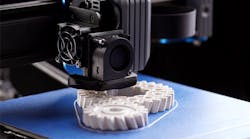3 ways 3D printing is becoming better, faster, and stronger
The field of additive manufacturing is continuously evolving. Every day, researchers across the world are pioneering new materials and methods to take 3D printing to the next level. Here are three groundbreaking techniques that are being utilized to make 3D printing better, faster, and stronger.
3D-printed metamaterial boasts supernatural strength
Researchers at RMIT University have engineered a new metamaterial using titanium alloy. The artificial material, which features unique properties not observed in nature, has a lattice structure and was shown in tests to be 50% stronger than the next strongest alloy of similar density. The structure, achieved through 3D printing, takes inspiration from hollow struts found in nature. The team utilized a new structure featuring a hollow tubular lattice structure that has a thin band running inside it, which allows stress to be more evenly distributed, avoiding weak points. The structure was 3D printed using a process called laser powder bed fusion. In this method, layers of metal powder are melted into place using a high-powered laser beam.
In a recent quote, study lead author and RMIT PhD candidate Jordan Noronha said, “Compared with the strongest available cast magnesium alloy currently used in commercial applications requiring high strength and light weight, our titanium metamaterial with a comparable density was shown to be much stronger or less susceptible to permanent shape change under compressive loading, not to mention more feasible to manufacture.”
SWOMP process 3D prints stronger material five times faster
Chemists and materials scientists at Sandia National Laboratories have created a new 3D printing process that prints stronger nonmetallic materials five times faster than conventional methods. The new technique, dubbed Selective Dual-Wavelength Olefin Metathesis 3D-Printing or SWOMP, uses dual-wavelength light, specifically ultraviolet and blue light. The team drew inspiration from several different approaches, including continuous liquid interface printing and a printing approach using dual-wavelength light for acrylic-based polymerizations.
In a recent quote, Samuel Leguizamon, materials scientist, said, “You are still printing layer by layer, but you are using a second wavelength of light to prevent polymerization at the bottom of the vat. So it doesn’t adhere to the bottom. That means you can lift the cured polymer part more quickly and speed up the printing process significantly.”
The team was also able to produce 3D-printed materials that are stronger and more versatile. Unlike traditional acrylic-based materials, the researchers turned to dicyclopentadiene, a product that is used in the production of paints, varnishes and flame retardants for plastics. Additionally, the team engineered a way to polymerize it more rapidly with light so that it can be used more efficiently in 3D printing.
Rapid 3D printing with liquid metal
Researchers at MIT have engineered a new additive manufacturing method that allows for rapid 3D printing with liquid metal. Using this new technique, dubbed liquid metal printing (LMP), molten aluminum is deposited along a predefined path into a bed of tiny glass beads where it quickly hardens. On the plus side, the new procedure is more energy efficient and is 10 times faster than conventional additive manufacturing methods. Unfortunately, some resolution is sacrificed in the process, so fine details are not achievable.
In a recent quote, Skylar Tibbits, associate professor in the Department of Architecture and co-director of the Self-Assembly Lab, said, “This is a completely different direction in how we think about metal manufacturing that has some huge advantages. It has downsides, too. But most of our built world — the things around us like tables, chairs, and buildings — doesn’t need extremely high resolution. Speed and scale, and also repeatability and energy consumption, are all important metrics.”
The Lighter Side of Manufacturing
Created by the editors of Plant Services and New Equipment Digest, The Lighter Side of Manufacturing is a feel-good blog that showcases how advances in science, math, engineering, and technology are making our world more whimsical. Here’s another post that is guaranteed to brighten your day.
Strand by Strand, Robots Are Changing Painful Hair Loss Treatments
ARTAS iXi is the future of hair restoration, providing precise and natural results.
